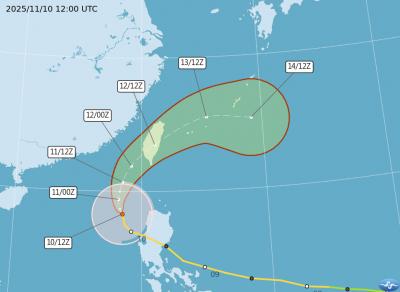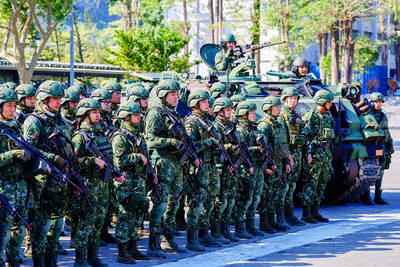The seasonal influenza vaccine and the Omicron JN.1-adapted COVID-19 vaccine are now available, the Centers for Disease Control (CDC) said yesterday, as it advised people to get vaccinated as soon as possible.
“The flu vaccine on the left arm and COVID-19 vaccine on the right arm, to be healthy and safe,” the CDC said, referring to a slogan for this year’s government-funded vaccination campaign.
Minister of Health and Welfare Chiu Tai-yuan (邱泰源) said the first phase of the government-funded vaccinations began yesterday, and people with higher exposure risk and higher risk of serious illness from infection are eligible.

Photo: Wang Yi-sung, Taipei Times
There are about 4,000 contracted healthcare facilities across the nation where people can get vaccinated, and they can find the facilities’ information on the Web sites of the CDC or local health departments, he said.
National Taiwan University Hospital Department of Family Medicine director Cheng Shao-yi (程劭儀) said the eligible groups include healthcare practitioners, people aged 65 years or older, care facility residents, children who are six-months-old to preschool age, parents of infants younger than six months, pregnant women, staff of nurseries and preschools, students, and people who deal with livestock-related and animal disease prevention work.
The aim of vaccination is to reduce the risk of hospitalization and death from infection, not ensuring that people would not get infected, Cheng said.
People should get the JN.1-adapted vaccine, as the mortality rate of COVID-19 hospitalization is still higher than that of the flu, she added.
The second phase of vaccination would start next month, with people aged 50 to 64 being eligible for the flu vaccine, and anyone older than six months being eligible for the COVID-19 vaccine, the CDC said.
Taiwanese actress Apple Huang (黃暐婷) and her husband, Carter Jaw (趙國翔), parents of a newborn, have become vaccination ambassadors, and they got COVID-19 and flu vaccines at the CDC yesterday.
Meanwhile, the centers said 51 local cases of dengue fever were reported in New Taipei City from Tuesday last week to Monday, and most of the cases visited a few hotspots in Jhonghe (中和) and Sindian (新店) districts, so they are related to the first cluster, adding up to 57 cases in total.
CDC Deputy Director-General Philip Lo (羅一鈞) said daily cases have been declining, with only one on Monday, indicating the city’s control measures have been effective.
Typhoon Krathon is expected to bring heavy rainfall this week, so removing standing water quickly after the typhoon would be a challenge, Lo said.
University of Taipei Department of Earth and Life Science associate professor Hwang Ji-sen (黃基森), a dengue expert, said when he inspected the hotspots — hiking trails near Sanjie Temple (三介廟) and Tianshan Park (天山公園) — he observed that the hourly mosquito biting rate was five to 20 per hour.
None of the residents and hikers he met at the hotspots took preventive measures against mosquito bites, and they were mostly elderly people, who are at higher risk of serious illness from infection, he said.
The city government should temporarily close the trails and the park to reduce dengue transmission, he said.
The primary carrier of dengue in northern Taiwan is Aedes albopictus (or the Asian tiger mosquito), which is native to Taiwan and one of the most dangerous invasive species in the world, he said, adding that it can be found in all administrative regions across the nation.
Hwang said the Asian tiger mosquito is typically active between 9am and 5pm, with peak activity hours being 9am to 10am and 4pm to 5pm, and it mainly stays outdoors, but it can also be attracted to indoor settings with standing water.
He said the largest dengue outbreaks in Taiwan in the past decade all occurred after typhoons swept over, so he strongly urged people to remove standing water, especially after heavy rainfall, and take preventive measures against mosquito bites.

The Central Weather Administration (CWA) today issued a sea warning for Typhoon Fung-wong effective from 5:30pm, while local governments canceled school and work for tomorrow. A land warning is expected to be issued tomorrow morning before it is expected to make landfall on Wednesday, the agency said. Taoyuan, and well as Yilan, Hualien and Penghu counties canceled work and school for tomorrow, as well as mountainous district of Taipei and New Taipei City. For updated information on closures, please visit the Directorate-General of Personnel Administration Web site. As of 5pm today, Fung-wong was about 490km south-southwest of Oluanpi (鵝鑾鼻), Taiwan's southernmost point.

Tropical Storm Fung-Wong would likely strengthen into a typhoon later today as it continues moving westward across the Pacific before heading in Taiwan’s direction next week, the Central Weather Administration (CWA) said. As of 8am, Fung-Wong was about 2,190km east-southeast of Cape Oluanpi (鵝鑾鼻), Taiwan’s southernmost point, moving westward at 25kph and possibly accelerating to 31kph, CWA data showed. The tropical storm is currently over waters east of the Philippines and still far from Taiwan, CWA forecaster Tseng Chao-cheng (曾昭誠) said, adding that it could likely strengthen into a typhoon later in the day. It is forecast to reach the South China Sea

Almost a quarter of volunteer soldiers who signed up from 2021 to last year have sought early discharge, the Legislative Yuan’s Budget Center said in a report. The report said that 12,884 of 52,674 people who volunteered in the period had sought an early exit from the military, returning NT$895.96 million (US$28.86 million) to the government. In 2021, there was a 105.34 percent rise in the volunteer recruitment rate, but the number has steadily declined since then, missing recruitment targets, the Chinese-language United Daily News said, citing the report. In 2021, only 521 volunteers dropped out of the military, the report said, citing

Nearly 5 million people have signed up to receive the government’s NT$10,000 (US$322) universal cash handout since registration opened on Wednesday last week, with deposits expected to begin tomorrow, the Ministry of Finance said yesterday. After a staggered sign-up last week — based on the final digit of the applicant’s national ID or Alien Resident Certificate number — online registration is open to all eligible Taiwanese nationals, foreign permanent residents and spouses of Taiwanese nationals. Banks are expected to start issuing deposits from 6pm today, the ministry said. Those who completed registration by yesterday are expected to receive their NT$10,000 tomorrow, National Treasury